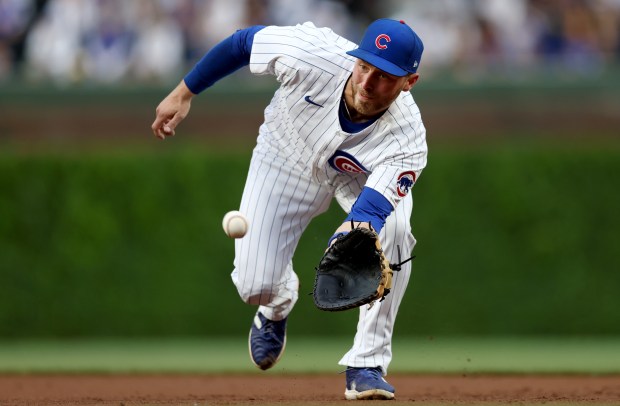SAN FRANCISCO — Michael Busch knew his chase rate and lack of walks were an unsustainable combination.
The electric beginning to Busch’s Chicago Cubs career featured an 11-game stretch in early April when the 26-year-old rookie clubbed three doubles and six home runs. The lefty slugger cooled off over the next month, though, posting a .170/.259/.277 slash line with 10 walks and 43 strikeouts in 108 plate appearances.
“I kind of got away from myself in a sense of getting a little too aggressive,” Busch told the Tribune. “It’s hard, like in 1-1, 1-2 counts, you’re not going to be perfect, but I was pretty upset at myself in 2-0, 2-1, 3-1 counts chasing out of the zone and letting the pitcher get back into the count.
“I’ve been getting punched, but I’m trying to punch back in the sense of understanding what pitchers are trying to do and execute that.”
As May turned to June, Busch saw signs of getting on track.
“I started chasing less, but I also was fouling off too many pitches,” he said. “You want to put the ball in play, you want to end the at-bat. But give myself some grace also — that’s been a pretty important part of my career is being able to foul pitches and not chase.”
While the Cubs entered their four-game series against the San Francisco Giants in an ongoing offensive funk, Busch has been one of their few bright spots. Since May 25 he is hitting .323 with a .432 on-base percentage and .932 OPS. Importantly, he has drawn 12 walks with 18 strikeouts in his last 74 plate appearances. His 128 OPS+ for the season leads the Cubs.
“I think I’ve done a good job of just laying off sliders down and in, heaters up, and those ultimately get me back into the zone and give me good pitches to hit,” Busch said.
In addition to being one of the few Cubs hitters locked in over the past month, Busch’s defense at first base should not be overlooked. Since moving to the position after an offseason trade from the Los Angeles Dodgers, Busch has stood out with his athleticism while honing the finer details of the position.
Coming into the year, Busch’s game experience at first base was limited to 17 starts over the previous three years in the Dodgers farm system.
“The important part is knowing balls I can get to,” he said, “and also making sure that the routine play to the shortstop, third baseman, second baseman, I’m not rushing back over there but also trying to get as much as I can. There were a few balls early on that I learned from quickly.”
Busch’s four outs above average (OAA) are tied for fourth and his three runs prevented rank fourth among the 40 qualified big-league first basemen. His range has played a role in those metrics. One of the hardest plays to read is a ball hit to the hole between first and second. The first step is vital on those plays as well as understanding which balls second baseman Nico Hoerner can get to.
Busch believes the key to success in those situations is staying aggressive.
“The speed of the ball has done a lot for me,” he explained. “If the ball is hit somewhat on a line or somewhat hard, Nico, even with his speed, is probably not going to get to a ball that I could get to. If it’s to my right with a right-handed hitter and it’s slow hit, he’s going to get there.
“But again, it’s hard. It’s a split-second decision. You want to trust your instincts.”
Busch and Hoerner were intentional during spring training while working on tweener balls, particularly important as Busch learned the Cubs’ defensive positioning tactics. Hoerner described first base as the most underrated position in baseball because of the impact on the team and the number of outs that end there.
“Defensive metrics at first base are pretty limited, too,” Hoerner told the Tribune, “because there’s so much that comes down to picks and tags, and all of that often isn’t quantified and just an incredibly important position that gives all of us confidence. I definitely appreciate how much he’s taken ownership of his craft there, and it has a big impact on our group.”
One of the toughest challenges — and an unique aspect of playing first base — is picking balls out of the dirt and the footwork needed to operate around the base. That has required the most time for Busch to get comfortable with.
He has come to understand, too, that at 6-foot-1, he’s not the tallest at the position, which requires understanding on wide throws when to come off the base and keep the ball in front of him.
Big-league coach Jonathan Mota, who works with Cubs infielders pregame and aligns them during games, has seen the most improvement in how Busch plays away from the base. Game reps have been especially valuable given Busch’s limited experience.
“Seeing where guys are hitting the ball most of the time, I’m able to move over and closer so I have plenty of time to get to the bag, and his picks, he’s been doing really good,” Mota said. “Again, that comes with reps and knowing tendencies from (Christopher) Morel, Dansby (Swanson), Nico and all his teammates.”
Manager Craig Counsell has been impressed by Busch’s performance in his first full big-league season. Busch isn’t satisfied but knows his best stretches this year show what he’s capable of against some of the game’s best arms.
“Yeah, you struggle, you go through some stuff,” he said. “It’s how quickly can you make that adjustment to get back.”



